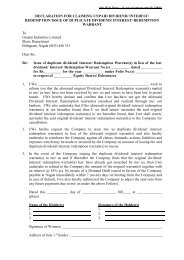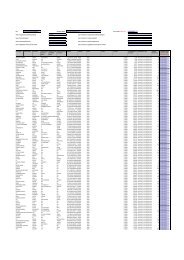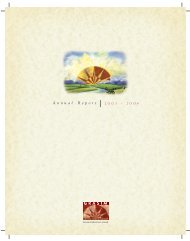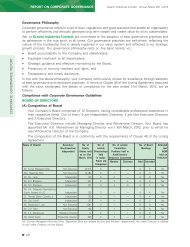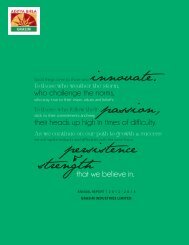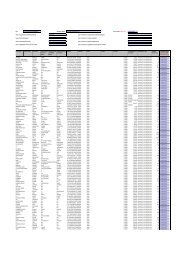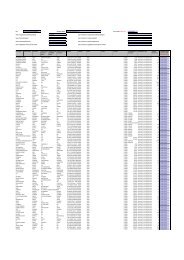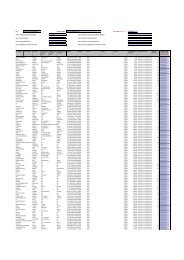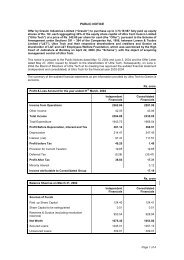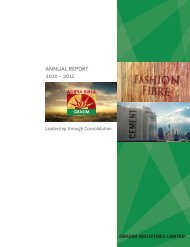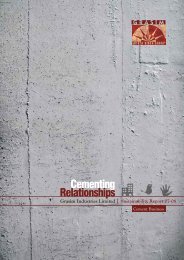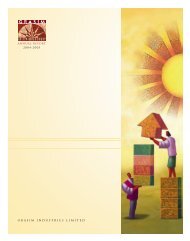2010-11 - Grasim
2010-11 - Grasim
2010-11 - Grasim
Create successful ePaper yourself
Turn your PDF publications into a flip-book with our unique Google optimized e-Paper software.
ULTRATECH CEMENT LANKA (PVT) LIMITED<br />
2.5 Going concern<br />
The Directors have made an assessment of the Company’s ability to continue as a going concern<br />
in the foreseeable future, and they do not intend either to liquidate or to cease trading.<br />
3. SIGNIFICANT ACCO<br />
CCOUNTING POLICIES<br />
The accounting policies set out below are consistent with those used in the previous year. Certain comparative<br />
amounts have been reclassified to conform to current year’s presentation.<br />
3.1. Foreign currency rency translation<br />
Transactions in foreign currencies are translated to Sri Lankan Rupees at the exchange rate applicable<br />
on the dates of the transactions. Monetary assets and liabilities denominated in foreign currencies at<br />
the reporting date are retranslated to the Sri Lankan Rupees at the exchange rate ruling at that date.<br />
Foreign currency exchange differences arising on translation are recognised in profit and loss.<br />
3.2. Assets and bases of their valuation<br />
Assets classified as current assets on the Balance Sheet are cash and bank balances and those which<br />
are expected to be realised in cash during the normal operating cycle or within one year from the<br />
reporting date, whichever is shorter.<br />
3.2.1. Propert<br />
roperty, , plant and equipment<br />
3.2.1.1<br />
.1. Owned<br />
Assets<br />
Items of property, plant and equipment are measured at cost less accumulated<br />
depreciation and accumulated impairment losses.<br />
The cost of property, plant and equipment includes expenditure that is directly attributable<br />
to the acquisition of the asset. The cost of self-constructed assets includes the cost of<br />
materials and direct labour and any other costs directly attributable to bringing the asset<br />
to a working condition for its intended use.<br />
3.2.1.2.<br />
Subsequent expendit<br />
xpenditure<br />
The cost of replacing a part of an item of property, plant & equipment is recogniszed in<br />
the carrying amount of the item if it is probable that the future economic benefits<br />
embodied within the part will flow to the Company and its cost can be measured<br />
reliably. The carrying amount of the replaced part is derecognised.<br />
The cost of the day-to-day servicing of property, plant & equipment are recognised in<br />
profit and loss as incurred.<br />
3.2.1.3.<br />
.3. Depreciation<br />
Depreciation is recogniszed in profit and loss on a straight-line basis over the estimated<br />
useful lives of items of each part of an item of property, plant and equipment.<br />
The estimated useful lives for the current period are as follows;<br />
Building<br />
25 Years<br />
Plant and Machinery<br />
18 Years<br />
Lab Equipment<br />
06 Years<br />
Electronic Installation<br />
18 Years<br />
Office Equipment<br />
04 Years<br />
Motor Cars<br />
05 Years<br />
Motor Cycles<br />
05 Years<br />
HT Power line<br />
18 Years<br />
Computers<br />
04 Years<br />
Software<br />
03 Years<br />
Furniture & Fittings<br />
06 Years<br />
Depreciation of an asset begins when it is available for use and ceases at the earlier of<br />
the date that the asset is classified as held for sale or is derecognized.<br />
Depreciation methods, useful lives and residual values are reassessed at the reporting<br />
date.<br />
3.2.2. Trade and other receivables<br />
Trade and other receivables are stated at their amounts estimated to realise.<br />
<strong>11</strong>9 ⊳



